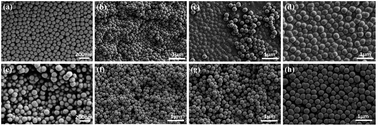Superhydrophobic coatings on gelatin-based films: fabrication, characterization and cytotoxicity studies†
Abstract
As a degradable natural biomaterial, gelatin has good biocompatibility and nontoxicity, but gelatin is easily soluble in water which has limited its application. In order to solve this tough defect, superhydrophobic gelatin films (GSF) were prepared by first grafting silica nanoparticles onto gelatin films and then modifying silica nanoparticles with a fluorosilane coupling agent (FAS). Fourier transform infrared spectroscopy (FTIR), scanning electron microscopy (SEM), a particle size analyzer, a contact angle instrument (CA), X-ray photoelectron spectroscopy (XPS), a universal materials tester and an Incucyte™ Zoom system were used to characterize the morphology, molecular interactions, superhydrophobic performance, and cytotoxicity. Results show that GSF300 modified by silica nanoparticles with a particle size of 303 nm has the largest contact angle (158.6°). At the same time, the contact angle is still more than 150° after 48 hours of infiltration in water. These results indicate that GSF300 has strong long-term water resistance. In addition, GSF300 has good mechanical strength, durability and nontoxicity. Therefore, such a durable, robust and superhydrophobic film has good potential applications in various functional biomedical aspects.



 Please wait while we load your content...
Please wait while we load your content...